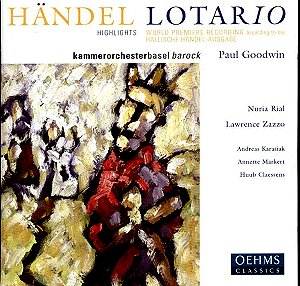Lotario (1729) is one
of the least well known of Handelís
operas. It was written in the aftermath
of the catastrophic losses incurred
by the composerís opera company following
the Haymarket audienceís lack of enthusiasm
and the exiting of the castrato Senesino,
a prize draw on the London stage. It
was further disadvantaged by a relatively
unfamiliar cast and a tale of knightly
derring-do that didnít appeal at all
to popular taste, which much preferred
the farce Hurlothrumbo, which
replaced the rapidly cancelled Lotario.
The libretto was in effect a wholesale
importation from Antonio Salviís Adelaide,
set to music by Orlandini and premiered
in 1726, though Handel would have heard
a 1729 Venice production of it. For
Handelís production the recitative was
tightened and there was quite an amount
of new textual material.
Whatever contemporary
response may have been thereís a fair
degree of captivating music with six
arias alone from the first act. This
live performance derives from a concert
(unstaged) given at the Martinskirche
in Basel with forces directed by Paul
Goodwin. The audience is unnervingly
quiet throughout but so successfully
taken are some of the arias that I canít
believe they sat there quite so meekly;
some post performance patching doubtless.
The only audience reaction otherwise
comes as a triumphal roar at the end;
merited as well.
The soloists are all
young and the band is crisply accomplished
(12-3-2-2 in the strings). Goodwin directs
warmly and his forces respond accordingly
Ė from the well-accented Overture onwards
they are invariably alert. The American
counter tenor Lawrence Zazzo takes the
title role and one can hear from his
first aria, Rammantati, cor
mio Ė this is an all-aria set and
there are no recitatives and only one
duet and one chorus Ė how well deployed
is his voice. Itís not a typical voice
for a European operatic or choral counter
tenor and is much more the very feminine
American soprano cultivated by, say,
David Daniels. Itís also strongly supported
at the bottom of its compass and flares
well at the top though very occasionally
thereís a little unsteadiness in the
middle of his range. His proves his
"soprano" spurs in Già
mi sembra with some virtuosic and
declamatory power and contributes to
the fine duet with real sensitivity,
as one would expect of this increasingly
renowned singer.
Tenor Andreas Karasiak
has a light, suave and persuasive voice
though limited opportunities to deploy
it Ė only the one aria. Annette Markert
proves a strong mezzo with a powerful
presence and a vibrato under perfect
expressive control. She announces herself
with a fine Vanne e colei che adori
and an equally good Impara, codardo.
Bass Huub Claessens also takes two
arias. He aspirates a touch and the
divisions can be a little sticky but
heís a really characterful singer, full
here of bumptious presence, though he
canít really make the extensions in
Non tíinganni la speranza. Which
leaves just the soprano Nuria Rial as
Adelaide. Sheís got a slightly breathy
voice but itís highly attractive and
her runs are remarkably fleet, accurate
and better still, crystal clear. She
is equally splendid in both her arias;
I suspect the earlier would have generated
the more applause but Non sempre
invendicata shows her in just as
good a light.
Just occasionally some
of Goodwinís rallentandi sounded rather
forced and imposed, rather than emerging
naturally from the impetus of the singing
and the dynamism of the music making
itself but this is of small account.
The performances are full of verve and
life. Texts and notes are in Italian,
German and English and the church acoustic
is unobtrusively, if slightly reverberantly,
fine. Thereís a complete recording on
DHM, which Iíve not heard. If one can
accept the highlights concept then this
is a successful disc. It serves however
to whet appetite for the complete recording
that these forces did give at the time
and which, presumably for economic reasons,
we donít have. Thatís a shame Ė but
these stand-alone highlights make a
sure showing.
Jonathan Woolf







